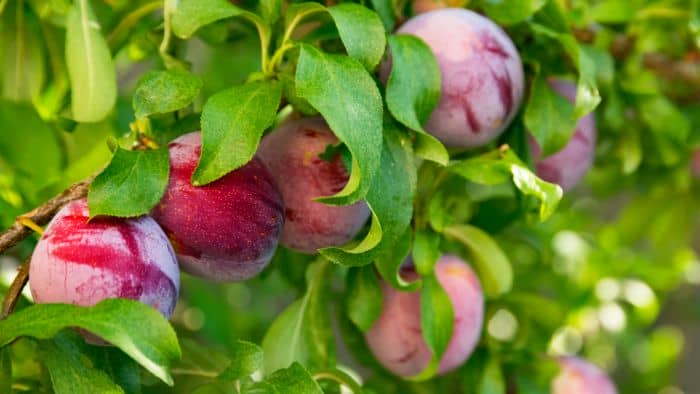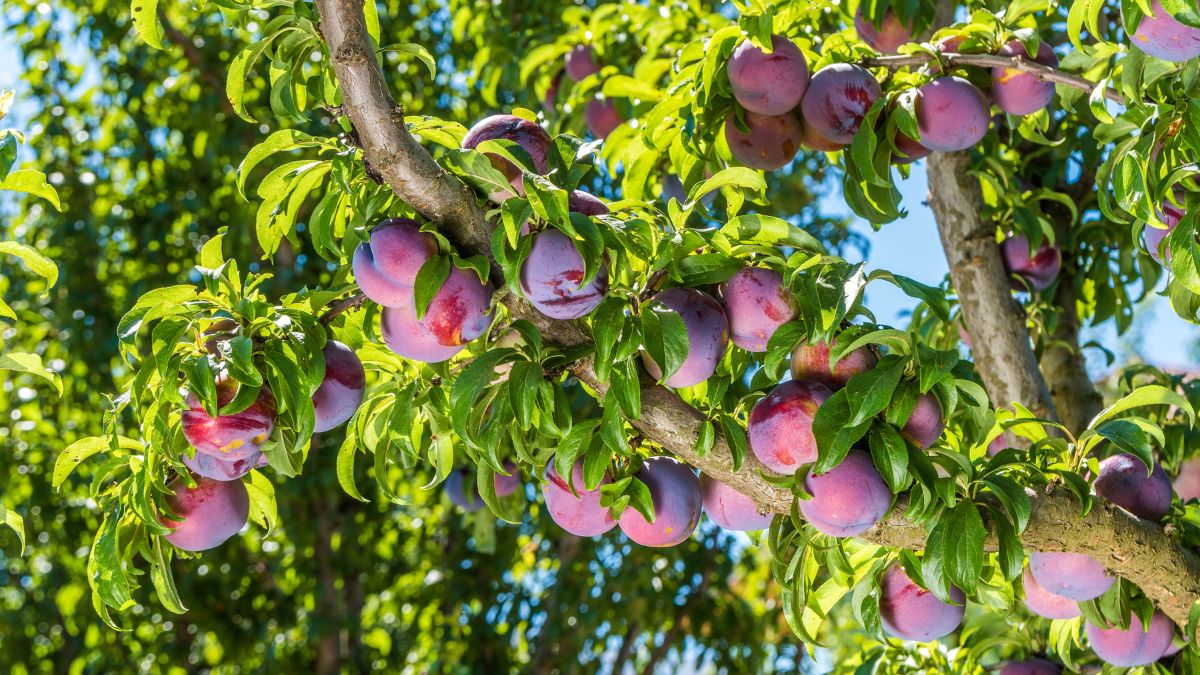What is the best soil for plum trees? Typically in a garden, we would always plant two different plum trees as a minimum to ensure pollination. To ensure that these trees thrive, we need the optimum soil. In this article, we look at how to ensure your soil is the best soil for plum trees – and pollination is right to get the biggest, juiciest plums.
What Is A Plum Tree?
Plum trees are a family of deciduous trees with a range right across the Northern Hemisphere. They produce delicious fruit (if planted in the right soil – this is why we need you to know what the best soil for plum trees is). In the wrong soil, they produce miserable sour fruit that not even the birds will eat. Plums flower in spring and produce beautiful showers of flowers for a week or two, and then a few months later they produce insane crops of fruit delicious fruit.
Plum trees are quite diverse in origin, and this article is not really about the origin of plums. Suffice it to say that there are a few starting species, and these have often been hybridized to produce plants that produce desirable fruit. When you have crossed two parent trees, and grown a tree from seed that produces a fruit that is desirable, branches of this mother tree can be grafted onto other rootstocks, allowing you to produce a clone line or cultivar. This can be from within one species (producing self-pollinating varieties) and between species (producing varieties that require cross-pollination).
When buying a cultivar, it is important to pair it with another cultivar that can cross-pollinate it. Because of the fact that most cultivars are hybrids, you need to choose two compatible cultivars that can cross-pollinate each other, otherwise, you will not get any fruit.
Typically, at the nursery, if you read the label on the plum tree it will say something like Methley plum or Santa Rosa – self-pollinating. If you plant a Methley or Santa Rosa, you do not need to plant another plum. However, if you see the label says Shiro plum, plant with Santa Rosa for cross-pollination, this means that you can have your Santa Rosa plum, and it will service your Shiro plum, giving you two types of plum in one garden.

I always try to plant two self-pollinating plums and one plum that needs cross-pollination. Hence in my garden, I have a Methley (grown by my Mom from a cutting) and one Santa Rosa, and one Shiro. If any of these were to die, I know I will still get a crop from the others. The fancy hybrids that need cross-pollination seem in my experience to be less hardy and more prone to disease.
Now that we know a basic overview of what a plum tree is, and how to select cultivars so we get fruit, let us find out what the best soil for plum trees is.
The Best Soil For Plum Trees – And How To Plant Plum Trees In This Soil
My town has heavy clay soil. This is definitely not the best soil for plum trees! Plum trees grow well in this soil if you understand what they need. A plum tree thrives in nutrient-rich soil – which clay is – but you can make sure your tree gets established faster if you understand what the best soil for plum trees is, and how to hack a sub-optimal soil to be acceptable. Plums can grow in nearly any soil, but if you make the soil more acceptable, they produce nicer fruit, faster.
Ideally, a plum thrives in the sorts of soils one would expect to find along river banks in their native range across Eurasia and North America. These are typically well-drained nutrient-rich sandy soils, to sandy clay loams. If you have similar soil, then this is the best soil for plum trees and you are in luck! The tree can however thrive in clay soil with the correct preparation.
How To Plant Plum Trees

If you have a sandy, or sandy clay loam, or even clay soil, you just really need to dig your soil over to a depth of a few feet and follow the next steps to turn it into the best soil for plum trees. If you measure out an area that is one square yard, dig this down to a depth of three to four feet. If the soil at the bottom is a bit clay like put this aside and replace it with better soil or river sand.
Take the heap of soil, and mix a pound of bone meal into this soil – this provides a slow release of phosphate over a few years, as well as some nitrogen. If you want your plant to really thrive, do not feel shy to include some pearlite. In my experience, there are few plants that will ever complain about incorporating pearlite in soil. I include it in the soil of every fruit tree I plant at a rate of about a quarter of the volume of soil in the hole I dig. This makes the soil in the starting hole soft, well-drained, and aerated – this is the best soil for plum trees. These are all good things in terms of getting a plant established fast – life is short – if you can have a tree producing fruit two years earlier by investing in a bit of pearlite, do so.
Plum Soil pH
Plum trees prefer slightly acidic soil, so do not add lime or wood ash. Rather add compost, which, in conjunction with the natural degradation of the material will provide a pH of 5.5-6 which is the pH range of the best soil for plum trees. Once your tree is established, keep feeding it a mulch layer of organic matter. Ideally, make a circular ring of rocks around the tree and keep a layer of organic matter such as leaves and manure in there that is a few inches deep. Replenish as needed being careful not to pack the organic matter against the tree trunk. This organic matter keeps the soil pH in the slightly acidic range needed – this is the best soil for plum trees in terms of pH.
Plum Tree Fertilizer
If you have dogs, dig small holes in the above-mentioned ring of organic matter, and you can place dog “manure” in these holes as it is available, and then cover this with soil and compost. This provides a decent supply of nitrogen, potassium, and phosphate and helps turn an irritating waste product into a resource. You cannot use dog manure in a vegetable garden as it is unsafe to have direct contact with crops you will eat. For fruit trees, it is safe manure as the fruits are not in contact with the soil.
If you do not have dogs you can use an organic fertilizer such as this one. I never promote the use of chemical fertilizers, not because I am some wild-eyed environmentalist, but because I like my fruit to taste good – and the micronutrients in organic blends help to achieve this objective. Chemical fertilizers tend to burn soil out with time and you get bland fruit similar to what you can buy in the shop.
Pollination
Please read this article I wrote on Mason bees and this article and how you can bring these harmless beautiful bees into your garden.
Conclusion
This little article combines my 40 or so years of plum tree how-to-grow experience! I hope it helps you, and now you know how to make the best soil for plum trees, maintain plum tree soil ph, how to plant plum trees, to plum tree fertilizer application! I hope you enjoy growing your plum trees, and that you, your family, and future generations will have as much fun eating, baking, making wine, making vinegar, and even having plum fights, as I have!!




